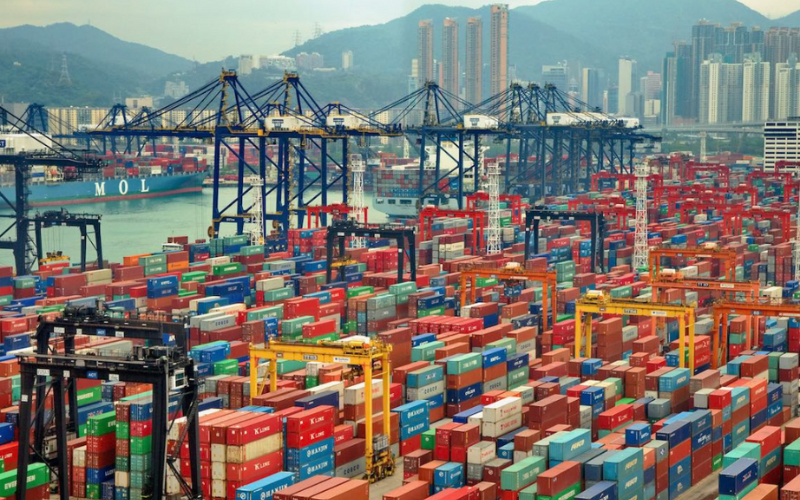Industry brands and retailers are scrambling to mitigate the impact of the Trump administration’s sweeping tariffs announcement on Wednesday as trade groups warned that already-stretched consumers can’t absorb higher prices.
“These new tariffs are a huge blow to fashion,” said Mallory Ottariano, the owner of apparel company Youer, in an email to SESO. Ottariano closed her Missoula production facility at the beginning of January to reduce costs and now produces all items in California.
Trump announced on Wednesday a baseline 10% tariff on goods from all countries, which take effect April 5, plus a series of tariffs on imported goods from a list of more than 60 countries that take effect on April 9. Chinese imports will have an additional 34% tariff, bringing the total to 54%. Vietnamese goods will be assigned a 46% tariff. And imports from the European Union will have a 20% tariff.
“We now only have one fabric coming out of China and it got bumped up to a 60% tariff,” Ottariano said. “What’s shocking is that this percentage is higher than if we were importing finished goods from China. Unfortunately this specific type of fabric and finishing is not available anywhere else in the world.”
Cassie Abel, the founder and CEO of technical apparel brand Wild Rye, said she was shocked by the announcement. The majority of Wild Rye’s products are made in China. Because tariffs already increased by 20% on Chinese goods in recent months, Abel has been working with factories to figure out how to absorb the increase through price increases, changing shipping methods, or altering service agreements.
“We were starting to feel like we might get through this,” Abel said. “And then we got the news yesterday that it’s not just raising our tariffs to 34%. It’s an additional 34% on top of the 20% that we were already slapped with, on top of the 7.5% that we were slapped with in the previous administration, on top of our normal HTS codes.” That means Wild Rye’s duties will range from 61% to 89.5%, she estimated.
Arkansas-based LIVSN makes all of its cut-and-sew products with partners in Vietnam – partners that Founder and CEO Andrew Gibbs-Dabney said took a chance on them at the beginning and made the company possible. For now, the company is assessing its options and waiting before taking any action.
“These suppliers have access to various quality materials, a robust collection of equipment, a skilled workforce, and pay a local living wage,” Gibbs-Dabney said. “Many of these things are not true of American manufacturing. If the tariffs stand at 46% or really any amount, we’ll have to raise prices to some degree. How much depends on our partnership with our suppliers and how much we can absorb before passing it on.”
Trade groups warned that consumers aren’t equipped to take on higher prices.
“This is catastrophic for American families,” Matt Priest, president and chief executive of the Footwear Distributors and Retailers of America, told The New York Times. “We had hoped the president would take a more targeted approach, but these broad tariffs will only drive up costs, reduce product quality and weaken consumer confidence.”
National Retail Federation (NRF) projected before the announcement on Wednesday that retail sales will grow in 2025 but also warned that economic uncertainty and tariffs will impact consumer spending.
“More tariffs equal more anxiety and uncertainty for American businesses and consumers,” said NRF Executive Vice President of Government Relations David French in a statement following Trump’s announcement. “While leaders in Washington may not care about higher prices, hardworking American families do.”
Stock prices of many publicly held apparel and footwear companies reacted poorly to the announcement. Nike shares fell by approximately 11% on Thursday morning. Dick’s Sporting Goods declined by more than 14%, VF Corp. fell by more than 19%, Deckers was down by more than 13%, and Columbia Sportswear was down by more than 9%.
The tariffs are designed to address “the national emergency posed by the large and persistent trade deficit that is driven by the absence of reciprocity in our trade relationships and other harmful policies,” according to a fact sheet shared by the White House. French said those additional costs will fall to consumers.
“Tariffs are a tax paid by the U.S. importer that will be passed along to the end consumer,” French said. “Tariffs will not be paid by foreign countries or suppliers.”
NRF projected at its State of Retail and the Consumer virtual event earlier on Wednesday that retail sales during 2025 will grow between 2.7% and 3.7% year-over-year to between $5.42 trillion and $5.48 trillion. But NRF and economists at the event said that after absorbing inflation and high interest rates for more than five years, many consumers won’t have room in their budgets to take on any more.
“We urge the administration and Congress to pursue a balanced approach to trade policy and tariffs, extend tax cuts needed to keep businesses competitive. and provide clear rules of the road for retailers to invest with confidence,” said Matthew Shay, NRF president and CEO, at the event.
Small Businesses are Vulnerable
Small business owner Sarah Wells, the CEO and founder of Sarah Wells Bags, said at the event the biggest uncertainty for her small business is tariffs.
“As tariffs increased, I’ve seen small business colleagues shutter their doors, and obviously I don’t want to follow the same path,” Wells said. The company has shifted its supply chain and manufacturers, examined its expenses and team members, and is engaging in advocacy. “But the pressure on small business right now is significant, and I really think that this emphasizes the need for small businesses to share their story and why the impact of tariffs in the future really threatens the livelihood of small businesses like mine.”
Katherine Cullen, NRF’s vice president of industry and consumer insights, warned at the Wednesday event that most households have burned through their pandemic boosted savings that came in the form of stimulus money. Over the past several years, she said wages have grown faster than inflation, which meant consumers could take on additional strain.
“But without the extra cushion from savings, consumers are now more vulnerable to economic shocks – things like even higher prices, job loss, or reduced wages,” Cullen said. “In other words, everything is great for the consumer until it isn’t, and some people are already feeling squeezed.”
Glimmers of Opportunity
Lower income earners are particularly vulnerable, said Kelly Pedersen, a partner at PwC’s global retail leader group. But there are some opportunities as well, he said, such as the Gen Z demographic, who are between the ages of 17 to 27.
“They’re coming of age in terms of income earnings and being able to spend in a bigger way in the economy,” he said.
Gen Z shoppers are particularly interested in shopping in-store in addition to shopping online, he said, because of social interaction, for service, or just to learn more information about products. That presents an interesting challenge to retailers to take increased traffic to stores and aim to convert them into sales through technology or immersive experiences.
Apparel sales are also getting a boost from people generally feeling happier, Pedersen said, which is partly attributed to the increased popularity of GLP-1 weight loss drugs.
“We’ve seen that up to 10% of the U.S. population is already on these,” he said. “We’ve done some surveys on this, and what we’re finding is people say that they’re generally happier, which means they want to be out more, they want to go buy more clothes, they want to go on more vacations.”
Consumers are also showing that they value celebrations and special events more, Cullen added.
“Whether that’s happiness or people even responding a little bit to uncertainty and saying, ‘I want to value this time with my friends and family,’ we’re seeing more interest around those events,” Cullen said. “Whether it’s Easter, Mother’s Day, or other events coming throughout the year, consumers are really protective of those.”
Income and Household Wealth Growth to Slow in 2025
U.S. GDP growth is expected to drop just below 2% in 2025, said Jack Kleinhenz, NRF’s chief economist, compared to 3% growth in 2024.
“That’s down from 2.8% in 2024 and it’s below the trend of the past few years,” Kleinhenz said. NRF does not expect the labor market to significantly weaken this year, but it does expect slower income and household growth. Consumer spending growth will also drop to slightly above 2%, down from 2.8% in 2024, he said.
“Needless to say, public policy shifts have introduced a significant level of unpredictability, raising the probability of a much slower pace of economic activity,” he said. “Any way you look at it, a lot is riding on the consumer.”
That said, consumer fundamentals remain intact, he said, with low unemployment and slow but steady income growth. It’s hard to predict how much unsettled consumer attitudes will impact household spending.
Gregory Daco, chief economist at EY, said consumer spending is strong, but slower income growth will likely impact spending in the near future. Elevated prices and interest rates, which are highly visible, will also deter spending.
“I have a constructive outlook, slightly lower than 2% growth in consumer spending by the end of 2025 but not a major retrenchment, so more caution on the part of consumers, and perhaps a greater share of spending that’s done by higher income individuals,” Daco said.
Tariffs will drive prices up further, Daco said, and businesses are likely aiming to get ahead of their impact by ordering ahead and importing in advance.
“That in itself is putting inflationary pressures via supply chains that are under more stress,” he said.
Uncertainty Affecting Investment, Lending, and More
Uncertain and rapidly changing economic and trade policies could also be impacting business investment, Daco said.
“For many businesses, there was this belief that we would have more of a pro-business sentiment, supporting greater CapEx, greater investment,” Daco said. “Instead, what we’ve seen is a little bit of a wait-and-see because people don’t really know what types of tariffs are going to be put in place, when they will be put in place, how they will be put in place, what types of goods are going to be affected. Are there going to be exclusion exemptions? And that is leading to a bit of a wait and see approach and a little bit of a hold on potential business investment.”
Sarah Wolfe, senior economist and strategist at Morgan Stanley, said the uncertainty is impacting businesses and their ability to plan ahead. It is also impacting lending, she said.
“The lower income households are going to be a lot more sensitive to lending standards by banks and to interest rates, and so I think this creates a new level of uncertainty for this year where you’re starting to see consumers are demanding more credit and loan growth is starting to turn a corner,” she said.
On the other hand, it’s unclear how much interest rates will come down in 2025 and how much banks will be able to loan low-income households.
“And if we’re not going to get lower interest rates delivered this year, I do think it creates another year where the low-income household could feel like they’re in a recession,” she said. “And so I’m very focused on the interest rate outlook as being the one saving grace amid all this policy uncertainty.”
High-income consumers could also be impacted by tariffs because of their impact on markets, she said.
“What type of market reaction could we see, and could that really hit high income spending? I think that’s probably an underappreciated risk,” Wolfe said.
Immigration policy will also impact labor, income, and consumer spending, Wolfe said.
“With stricter immigration policies, whether it’s shutting down asylum programs, whether it’s through deportations, or reduced flows at the border, which have been very effective, we’ve already seen a sharp slowdown in immigration that is going to slowly translate into weaker labor force flows, weaker job growth,” she said. “And if you have fewer people in the economy making money, you have fewer people in the economy spending as well, right? You’re losing supply and demand, and so that’s one factor that’s going to start to weigh on consumer spending this year.”
Kate Robertson can be reached at kate@shop-eat-surf-outdoor.com.






